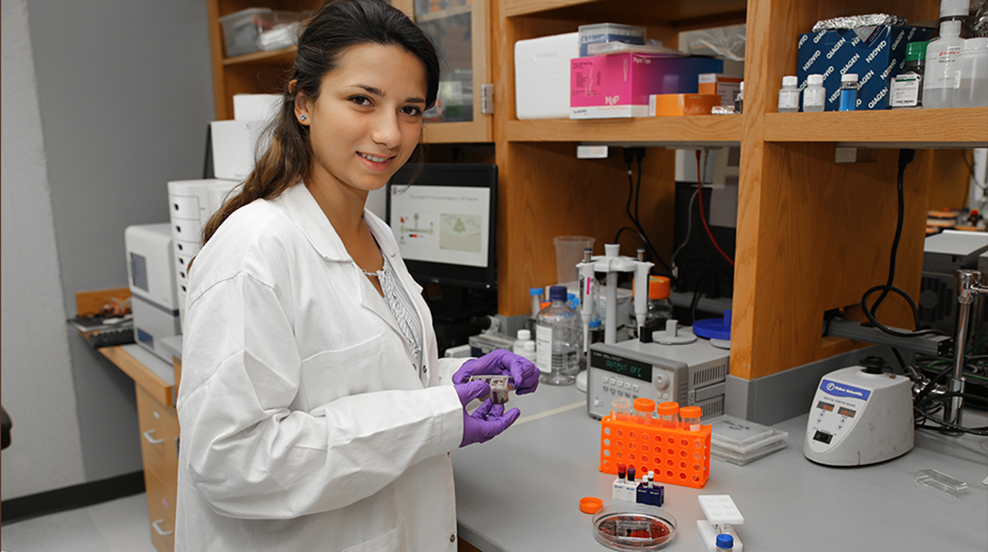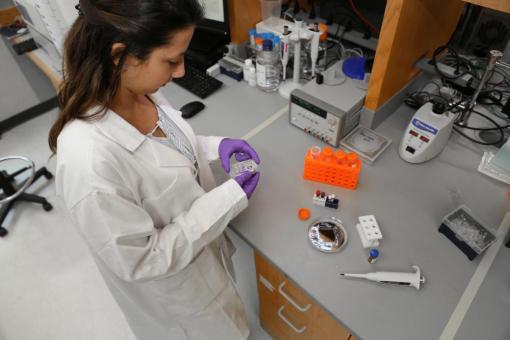 DiMase Summer Fellowship allows senior to explore tumor cell separation and isolation from conception to prototype.
DiMase Summer Fellowship allows senior to explore tumor cell separation and isolation from conception to prototype.
From the time she first stepped foot onto College Hill, there was little doubt Ileana Pirozzi '18 was right where she was supposed to be. Without delay, she delved into chemistry research, designing and developing an experiment to provide hands-on learning of quantum mechanics. Investigating wave mechanics by synthesizing silver nanoparticles, it took her just two semesters and a summer Undergraduate Research and Teaching Award to assist in implementing a new undergraduate experiment that is now used in introductory organic chemistry labs.
"Professor (Anubhav) Tripathi told me to start research early," she said matter-of-factly, referring to her freshman advisor, who continues to serve as mentor and instructor to the senior from Italy. "I attended a UWC (United World College), an international high school, where I received a very liberal education, which shaped how I now view education, valuing every aspect of holistic learning - creativity, invention and expression.
"Only a few certain universities then, made sense for me to attend. Brown has helped me in that it has been exactly what it advertises to be. So from the beginning, it was a natural transition for me."
Transitions appear easy for the likeable 20-year-old, who, in her sophomore year, made the move back to biomedical engineering, joining the Tripathi Lab and focusing on medical diagnostics, and a translational approach to medicine. As a sophomore and junior, she joined the lab's work on cancer cell detection, working with an oil and water interface on a microfluidic device to isolate rare cancer cells from whole blood via immunomagnetic capture. She worked independently and persistently to improve upon the device, illustrating her versatile skills in the laboratory.
"Ileana came to my lab driven to contribute in a meaningful way," Tripathi said. "She continually shows the desire to take on challenging problems and work with complicated instruments that others have avoided."
"For me, the beauty of it all is really in the way it comes together," Pirozzi said. "As a biomedical engineer, you have to understand the governing physics and mathematical principles, but also be an expert in biology. It is so interesting, yet challenging, to combine these equally fascinating aspects of my degree: To understand pressure and velocity profiles in microfluidic flows as well as critical frequency of rotation, while keeping in mind the effects of shear rates on live cells. These are the reasons I love BME," she mused.
Before the end of her junior year, Pirozzi's research had led to an original manuscript, along with an invitation to present at the Biomedical Engineering Society's annual meeting in Phoenix in October. The device her research centers around demonstrates high purity and high selectivity, making it a competitive option for diagnostics, while its compact size makes it a potentially portable, point-of-care diagnostic device. This is an important part of what attracts Pirozzi to the lab every day - the idea that diagnostics exemplifies how engineering helps human lives.
By spring of her junior year, she had also seen enough convergence of physics, math and biology to propose her own new device idea for cancer cell separation, isolation and subsequent on-chip assays, by exploiting centrifugal and Coriolis forces to compartmentalize cells. She proposed the idea to Tripathi, and a Vincent and Ruby DiMase fellowship over the summer helped finance the opportunity to explore this newest "lab-on-a-chip" idea.
 She spent the summer conceptualizing the project, developing the computational model and design optimizations to get to a prototype. She hopes to begin first testing soon.
She spent the summer conceptualizing the project, developing the computational model and design optimizations to get to a prototype. She hopes to begin first testing soon.
"Most importantly, this fellowship enabled me to appreciate, from start to end, the dedication, frustration and satisfaction of seeing your own project grow from a conceived idea to a working prototype," Pirozzi said. "The roadblocks forced me to troubleshoot and think creatively, and increased my appreciation for science and research. The personal and professional growth I experienced means more than a summer project, marking an important step of my scientific training.
"Thanks to the DiMases, I was able to balance living expenses and project budgeting, which is a truly educational experience for a developing scientist."
As incoming President of Tau Beta Pi (Engineering's Honor Society), Pirozzi is embarking on some new ideas for top Engineering students to assume roles of leadership and service with distinction, and aims to develop initiatives to benefit the entire Brown Engineering community. She is also a member of the International Genetically Engineered Machine (iGEM) '17 team, a joint effort between Stanford University and Brown. The iGEM Foundation is a non-profit organization dedicated to the advancement of synthetic biology, and the development of an open community and collaboration by sharing standard DNA parts. Pirozzi's contributions include working on self-healing materials for the mission and bioBactery, a biological replacement to a chemical battery inspired by the natural structure of electric eels.
She'll be applying to graduate schools, looking to pursue a Ph.D. in biomedical engineering, and leaving the future open to either academia or industry, but in either case "likely in the field of medical diagnostics," she said. "Biomedical engineering is about identifying needs and developing solutions. It's about applying science to improve human life."
by Beth James